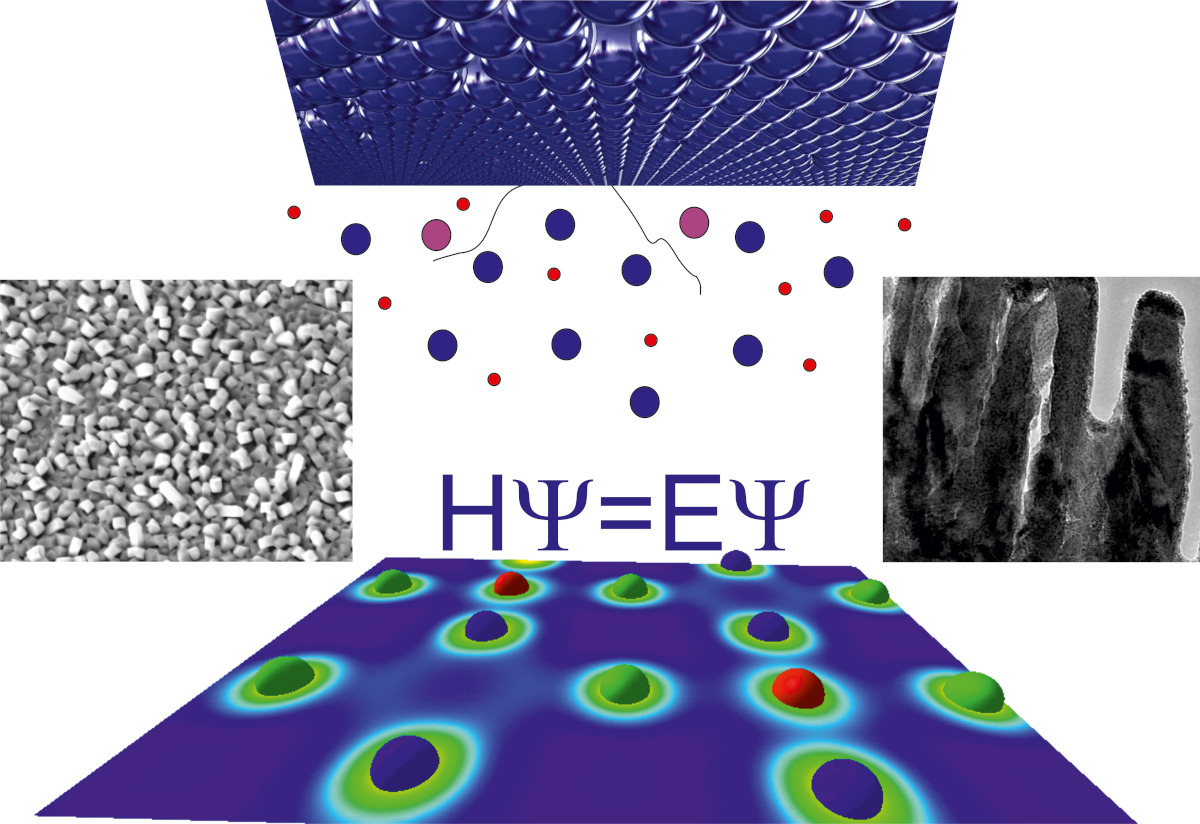Nowadays, energy prices are rising, making it more and more demanding to support our modern economy. The notion of a net zero carbon footprint in conjunction with cheap energy sources is realized with thermoelectric devices, which directly convert heat into electricity. This effect was discovered by T. J. Seebeck two centuries ago and it was named after him. Clearly, this is compatible with the UN Sustainable Goals. The core of our research has been carried out on thermoelectric thin films, but other energy conversion phenomena have been explored and exploited, especially when hybrid devices are conceivable. Energy storage is another issue of interest. The performed research is both synergistic and holistic. The buzz-word synergy refers herein to a combination of theoretical and experimental efforts to reach a goal at hand, while a holistic approach relates to exploration of not only primary physical properties, but also secondary.
Our main method to grow thin films is sputtering. It is the process by which atoms of a target (source) material are ejected due to bombardment by energetic particles. It is used to provide a material to be deposited in the form of a film on an object, called a substrate. A sputtering target is a negatively biased plate of the material to be deposited. Positive ions, such as argon, hit the target due to a potential difference and eject the neutral atoms as well as electrons. These secondary electrons are of importance since they can further ionize argon atoms in the close vicinity. More argon ions are attracted towards the target, and this triggers a self-sustained process. Thus, plasma occurs, an ionized state of matter. Sputtering allows for synthesis of non-equilibrium structures, “circumventing” traditional thermodynamics.
Density functional theory and large-scale facilities can help discover wonders of small scales. Why is this important? There are at least two reasons: (i) we can understand how thin films grow only if we consider the smallest of scales and (ii) physical and chemical properties are often drastically altered on the nanoscale. Anybody can name common properties of gold, such as good conductivity and inertness. Taking the same material without any structural (atomic arrangement) or chemical modifications, it becomes semiconductive upon a decrease in its physical size down to the nanoscale. Amazing! Additionally, new physical mechanisms are valid on such scales which is relevant for thin film nucleation and growth.
Thermoelectric devices can be used as temperature sensors, so it is sound to endeavor other sensing applications. Detecting single molecules is quite challenging, but due to enormous surface to bulk ratio nanostructures are ideal sensors, whereby thermoelectric materials are often nanostructured to damp phonon transport and hence increase their efficiency. Thermoelectric devices may also power biomedical devices such as pacemakers and eventually biosensors (hence self-powered biosensors).
[{"id":548,"link":"https:\/\/materials.uni.mau.se\/euro-nano-forum-2023\/","name":"euro-nano-forum-2023","thumbnail":{"url":false,"alt":false},"title":"Euro Nano Forum 2023","author":{"name":"materials group","link":"https:\/\/materials.uni.mau.se\/author\/ai6698\/"},"date":"jun 13, 2023","dateGMT":"2023-06-13 11:37:45","modifiedDate":"2023-06-13 11:37:47","modifiedDateGMT":"2023-06-13 11:37:47","commentCount":"0","commentStatus":"open","categories":{"coma":"<a href=\"https:\/\/materials.uni.mau.se\/category\/energy\/\" rel=\"category tag\">energy<\/a>","space":"<a href=\"https:\/\/materials.uni.mau.se\/category\/energy\/\" rel=\"category tag\">energy<\/a>"},"taxonomies":{"post_tag":""},"readTime":{"min":0,"sec":9},"status":"publish","excerpt":""},{"id":545,"link":"https:\/\/materials.uni.mau.se\/eurpean-materials-research-society\/","name":"eurpean-materials-research-society","thumbnail":{"url":false,"alt":false},"title":"Eurpean Materials Research Society","author":{"name":"materials group","link":"https:\/\/materials.uni.mau.se\/author\/ai6698\/"},"date":"jun 2, 2023","dateGMT":"2023-06-02 11:32:39","modifiedDate":"2023-06-13 11:36:15","modifiedDateGMT":"2023-06-13 11:36:15","commentCount":"0","commentStatus":"open","categories":{"coma":"<a href=\"https:\/\/materials.uni.mau.se\/category\/energy\/\" rel=\"category tag\">energy<\/a>","space":"<a href=\"https:\/\/materials.uni.mau.se\/category\/energy\/\" rel=\"category tag\">energy<\/a>"},"taxonomies":{"post_tag":""},"readTime":{"min":0,"sec":16},"status":"publish","excerpt":""},{"id":519,"link":"https:\/\/materials.uni.mau.se\/steps-toward-a-sustainable-future\/","name":"steps-toward-a-sustainable-future","thumbnail":{"url":false,"alt":false},"title":"Steps toward a sustainable future","author":{"name":"materials group","link":"https:\/\/materials.uni.mau.se\/author\/ai6698\/"},"date":"jan 17, 2023","dateGMT":"2023-01-17 07:48:00","modifiedDate":"2023-01-26 07:51:36","modifiedDateGMT":"2023-01-26 07:51:36","commentCount":"0","commentStatus":"open","categories":{"coma":"<a href=\"https:\/\/materials.uni.mau.se\/category\/energy\/\" rel=\"category tag\">energy<\/a>, <a href=\"https:\/\/materials.uni.mau.se\/category\/hydrogen\/\" rel=\"category tag\">hydrogen<\/a>, <a href=\"https:\/\/materials.uni.mau.se\/category\/sustainability\/\" rel=\"category tag\">sustainability<\/a>","space":"<a href=\"https:\/\/materials.uni.mau.se\/category\/energy\/\" rel=\"category tag\">energy<\/a> <a href=\"https:\/\/materials.uni.mau.se\/category\/hydrogen\/\" rel=\"category tag\">hydrogen<\/a> <a href=\"https:\/\/materials.uni.mau.se\/category\/sustainability\/\" rel=\"category tag\">sustainability<\/a>"},"taxonomies":{"post_tag":""},"readTime":{"min":0,"sec":20},"status":"publish","excerpt":""},{"id":474,"link":"https:\/\/materials.uni.mau.se\/10-year-anniversary-of-medicon-village\/","name":"10-year-anniversary-of-medicon-village","thumbnail":{"url":false,"alt":false},"title":"10 year anniversary of Medicon Village","author":{"name":"materials group","link":"https:\/\/materials.uni.mau.se\/author\/ai6698\/"},"date":"nov 24, 2022","dateGMT":"2022-11-24 06:51:00","modifiedDate":"2022-11-26 06:53:02","modifiedDateGMT":"2022-11-26 06:53:02","commentCount":"0","commentStatus":"open","categories":{"coma":"<a href=\"https:\/\/materials.uni.mau.se\/category\/energy\/\" rel=\"category tag\">energy<\/a>","space":"<a href=\"https:\/\/materials.uni.mau.se\/category\/energy\/\" rel=\"category tag\">energy<\/a>"},"taxonomies":{"post_tag":""},"readTime":{"min":0,"sec":17},"status":"publish","excerpt":""},{"id":423,"link":"https:\/\/materials.uni.mau.se\/grzegorz-presents-at-annual-biofilms-workshop\/","name":"grzegorz-presents-at-annual-biofilms-workshop","thumbnail":{"url":false,"alt":false},"title":"Grzegorz presents at annual Biofilms workshop","author":{"name":"materials group","link":"https:\/\/materials.uni.mau.se\/author\/ai6698\/"},"date":"okt 31, 2022","dateGMT":"2022-10-31 06:48:00","modifiedDate":"2022-11-20 07:04:11","modifiedDateGMT":"2022-11-20 07:04:11","commentCount":"0","commentStatus":"open","categories":{"coma":"<a href=\"https:\/\/materials.uni.mau.se\/category\/energy\/\" rel=\"category tag\">energy<\/a>","space":"<a href=\"https:\/\/materials.uni.mau.se\/category\/energy\/\" rel=\"category tag\">energy<\/a>"},"taxonomies":{"post_tag":""},"readTime":{"min":0,"sec":22},"status":"publish","excerpt":""},{"id":397,"link":"https:\/\/materials.uni.mau.se\/funding-for-new-equipment-for-thin-film-growth\/","name":"funding-for-new-equipment-for-thin-film-growth","thumbnail":{"url":false,"alt":false},"title":"Funding for new equipment for thin film growth","author":{"name":"materials group","link":"https:\/\/materials.uni.mau.se\/author\/ai6698\/"},"date":"okt 17, 2022","dateGMT":"2022-10-17 09:57:00","modifiedDate":"2022-11-18 10:00:09","modifiedDateGMT":"2022-11-18 10:00:09","commentCount":"0","commentStatus":"open","categories":{"coma":"<a href=\"https:\/\/materials.uni.mau.se\/category\/energy\/\" rel=\"category tag\">energy<\/a>","space":"<a href=\"https:\/\/materials.uni.mau.se\/category\/energy\/\" rel=\"category tag\">energy<\/a>"},"taxonomies":{"post_tag":""},"readTime":{"min":0,"sec":17},"status":"publish","excerpt":""},{"id":394,"link":"https:\/\/materials.uni.mau.se\/new-phd-student-welcome-sana\/","name":"new-phd-student-welcome-sana","thumbnail":{"url":false,"alt":false},"title":"New PhD student: Welcome Sana!","author":{"name":"materials group","link":"https:\/\/materials.uni.mau.se\/author\/ai6698\/"},"date":"okt 3, 2022","dateGMT":"2022-10-03 09:51:00","modifiedDate":"2022-11-18 09:57:02","modifiedDateGMT":"2022-11-18 09:57:02","commentCount":"0","commentStatus":"open","categories":{"coma":"<a href=\"https:\/\/materials.uni.mau.se\/category\/energy\/\" rel=\"category tag\">energy<\/a>","space":"<a href=\"https:\/\/materials.uni.mau.se\/category\/energy\/\" rel=\"category tag\">energy<\/a>"},"taxonomies":{"post_tag":""},"readTime":{"min":0,"sec":15},"status":"publish","excerpt":""}]
